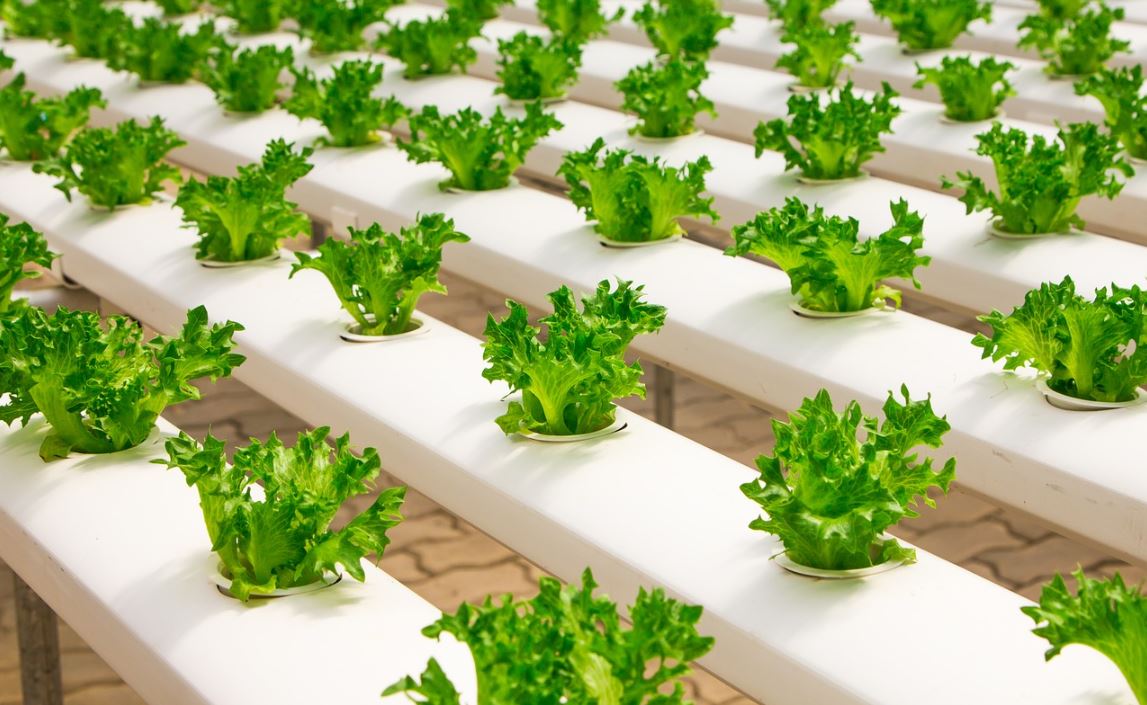Hydroponics, a subset of hydroculture, is the art of growing plants without soil. Plants grow with just mineral solutions in a water solvent – and nothing else.
Put simply; hydroponics is the science of growing plants in water that contains all the essential nutrients they need – specifically, the nutrients they need to grow, flower, and fruit.

Hydroponics for Beginners, a guide published by RO-SYSTEM REVIEWS, has the following definition of the term:
“Hydroponics is a way of growing plants without soil, directly in a mixture of water and nutrients through a growing medium like expanded clay.”
Nutrient Film Technique
When we hear the term ‘hydroponics,’ we image plants with their roots suspended directly into water with no growing medium. This, however, is just one type of hydroponic technique. We call it the Nutrient Film Technique (NFT).
Simplyhydro.com says the following about NFT:
“There are several variations of N.F.T. used around the world and it is a very popular method of growing hydroponically.”
“What most people don’t realize is that there are countless methods and variations of hydroponic gardening.”
The nutrients people use today in hydroponic systems come from a variety of sources. A by-product of duck manure, for example, is one source. So are fish waste by-products. Some growers use chemical fertilizers.

Etymology of hydroponics
Etymology is the study of the history of words and how their structures and meanings have evolved.
The term ‘hydroponics’ with the meaning ‘process of growing plants without soil’ emerged in the English language in 1937.
It is formed from ‘hydro-,’ which means ‘water’ in Greek, and ‘-ponics.’ from the Greek word ‘ponein’ which means to ‘toil, labor.’
Benefits of hydroponics
There are many benefits associated with growing plants in a solution of nutrients mixed with water: (Data Source: The Spruce)
- Plants grow significantly faster – up to 20% faster than they do in soil.
- In areas where existing soil is poor, hydroponics is the ideal option.
- Yields are from 20% to 25% greater compared to soil. Yield, in this context, refers to crop production per unit area.
- It requires considerably less space. The plant does not have to grow an extensive root system to get its nutrients. Therefore, they can be packed very close to each other.
- This technique uses much less water.
Moreover, advancements in LED lighting technology have made hydroponic systems more energy-efficient, supporting plant growth with less environmental impact.
Hydroponics is not new
Although the word is less than a century old, we have been growing plants in a water solution for a very long time.
In his book ‘Hydroponic Food Production,’ Howard M Resh writes:
“The hanging gardens of Babylon, the floating gardens of the Aztecs of Mexico, and those of the Chinese are examples of Hydroponic culture. Egyptian hieroglyphic records dating back several hundred years B.C. describe the growing of plants in water.”
In 1627, Francis Bacon’s book ‘Sylva Slvarum’ (or ‘A Natural History’) was printed. In his book, Bacon wrote about growing terrestrial plants without soil. ‘Water Culture‘ became increasingly popular after his book came out.
Hydroponics market set to grow
A Research and Market report predicts that the global hydroponics market will be worth $724.87 million by 2023.
In a press release, Research and Markets wrote:
“Decrease in arable land, growing population coupled with rising demand for food, and technological advancements in hydroponics are some of the factors boosting the market growth.”
“In addition, increasing research & developments investments, raising adoption of vertical farming are propelling the market growth. On the other hand, high initial investments and complexity in technologies are some of the restraints hindering market growth.”
Forecasters say that the market in Europe will probably grow faster than anywhere else in revenue terms. The Asia Pacific region will also experience significant growth.
Additionally, the use of smart technology in monitoring nutrient solutions and plant health is paving the way for more precise and automated hydroponic systems, enhancing both the scalability and ease of management for growers.
Exploring Hydroponics Vocabulary
There are many terms in the English language containing two or more words that contain the word ‘hydroponics.’ We call them compound phrases. Let’s have a look at some of them:
-
Hydroponics Setup
The arrangement and assembly of a hydroponic system where plants will be grown. Here is an example of the term in context:
“Her ‘hydroponics setup’ at home includes various types of leafy greens and culinary herbs.”
-
Hydroponics Growing System
A setup that includes all necessary components such as nutrient solutions, water, and support for plants to grow hydroponically. As in:
“The ‘hydroponics growing system’ in John’s greenhouse allows him to cultivate herbs year-round.”
-
Hydroponics Nutrient Solution
The water-based solution that contains essential minerals and nutrients for plant growth in hydroponics. For instance:
“To ensure optimal growth, regularly check the pH and nutrient concentration of your ‘hydroponics nutrient solution’.”
-
Hydroponics Research Lab
A facility dedicated to studying and improving hydroponic growing techniques and technologies. As in:
“The ‘hydroponics research lab’ at the university is leading innovative studies on urban farming solutions.”
-
Hydroponics Farming Kit
A packaged set of equipment and supplies designed for beginners or enthusiasts to start their own hydroponic garden. For example:
“The ‘hydroponics farming kit’ includes everything you need to get started, from seeds to nutrient mixtures.”
-
Hydroponics Cultivation Method
The specific approach or technique used in growing plants in a soilless hydroponic environment. For example:
“Strawberries grown using the ‘hydroponics cultivation method’ often yield fruit much faster than traditional soil gardening.”
Video – What is Hydroponics
This interesting video presentation, from our YouTube partner channel – Marketing Business Network, explains what ‘Hydroponics’ is using simple and easy-to-understand language and examples.
